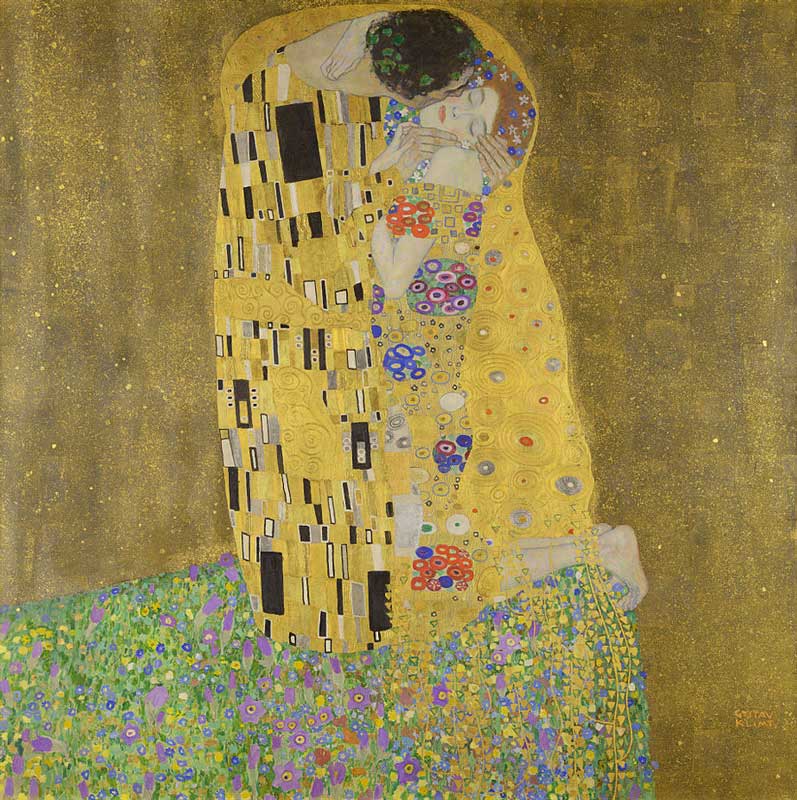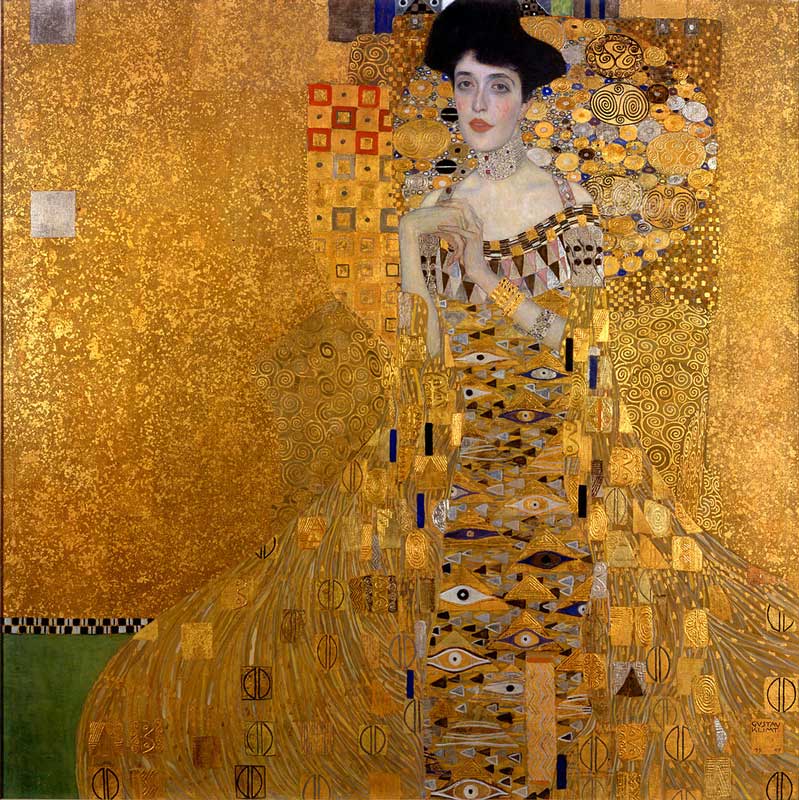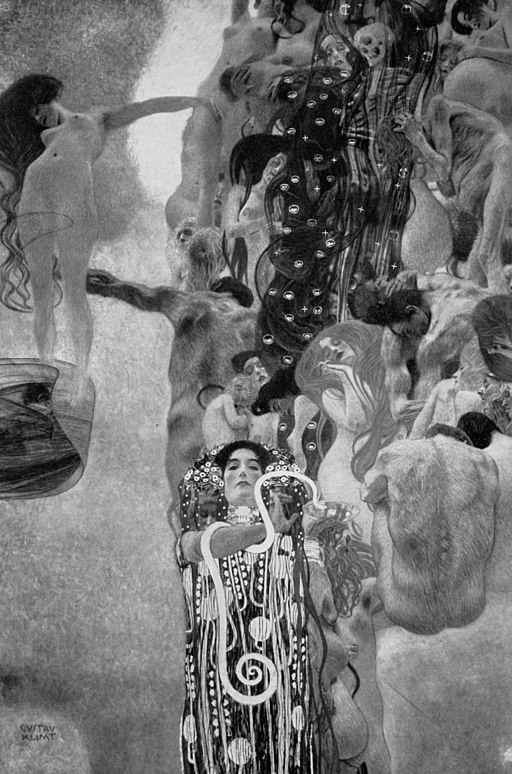Gustav Klimt is a much-admired artist by artists and collectors alike. The Austrian Symbolist painter, one of the most prominent members of the Vienna Secession movement, was highly recognized for his paintings, murals, sketches, and other objets d’art. His primary subject was the female body and his works are known for their unabashed eroticism. Although his rebellious spirit often attracted criticism he pursued his own artistic vision and enjoyed creative and financial success in his career until he died in at the age of 56 in 1918 soon after having a stroke and pneumonia.

Gustav Klimt, The Kiss, 1907–08, oil on canvas, 70-7/8″ x 70-7/8″. Österreichische Galerie Belvedere, Vienna. Photo: Google Art Project, Public Domain.
We can easily recognize a Gustav Klimt painting from across the museum hall. However, when we probe the depths of art history we discover the origins of Klimt’s inimitable style owe a debt of gratitude to other artistic influences including Egyptian, Minoan, Classical Greek, and Byzantine Byzantine and Japanese art, Art Nouveau, Monet’s Impressionism, the engravings of Albrecht Dürer, late medieval European painting, and Japanese Rimpa school.
The painting “The Kiss” which is thought to portray the artist with his lover Emilie Louise Flöge they are enveloped in robes inspired by Byzantine mosaics. It bears resemblance to the painting “Salome” by Aubrey Beardsley (1872 – 1898).
In 1892 an international event changed the course of art history. When Edvard Munch’s paintings were exhibited in Berlin they generated such bitter controversy that a number of radicals broke from the Union of Berlin Artists and formed the Berlin Seccession. This association quickly spread to Austria where Gustav Klimt established the Vienna Seccession with the purpose of raising the level of quality of the arts and crafts in Austria through close ties to Art Nouveau. The goals of the group were to provide exhibitions for unconventional young artists, to bring the works of the best foreign artists to Vienna, and to publish its own magazine to showcase the work of members. The government supported their efforts and gave them a lease on public land to erect an exhibition hall. Klimt remained with the Secession until 1908.
 Gustav Klimt, Adele Bloch-Bauer I, 1907, oil silver and gold on canvas, 55.1″ × 55.1″. Reportedly this painting was purchased by Ronald Lauder for a record $135 million in 2006, Neue Galerie, New York. Photo: Public Domain.
Gustav Klimt, Adele Bloch-Bauer I, 1907, oil silver and gold on canvas, 55.1″ × 55.1″. Reportedly this painting was purchased by Ronald Lauder for a record $135 million in 2006, Neue Galerie, New York. Photo: Public Domain.
During Klimt’s “Golden Phase” he produced many paintings that included gold leaf. This body of work received positive critical reaction and financial success. The works most popularly associated with this period are “The Kiss” and “Adele Bloch-Bauer I”. His paintings required painstaking details and patience.
We know that Gustav Klimt was born in Baumgarten, near Vienna in Austria-Hungary, on July 14, 1862. He was second of seven children and the son of a gold engraver. At the age of 30 Klimt’s father and brother Ernst died. He was forced to assume financial responsibility for his father’s and brother’s family. These tragedies affected his artistic vision and his pursuit of a personal style.
He was reportedly quite promiscuous and he never married. Emilie Louise Flöge (a sibling of his sister-in-law) was his primary companion. She was an Austrian fashion designer and Klimt designed many costumes she created and modeled in his works.
Very little can be found in the artist’s own words about his artistic vision or creative methods. However in his writing “Commentary on a non-existent self-portrait”, he states, “I have never painted a self-portrait. I am less interested in myself as a subject for a painting than I am in other people, above all women… There is nothing special about me. I am a painter who paints day after day from morning to night… Who ever wants to know something about me… ought to look carefully at my pictures.”

In 1894 Klimt was commissioned to create three paintings to decorate the ceiling of the Great Hall of the University of Vienna. Titled “Philosophy”, “Medicine” and “Jurisprudence” they were criticized for their radical themes and material, and were called “pornographic”. The public outcry was so widespread among the political, aesthetic and religious arenas. The paintings were never displayed at the University. After this incident Klimt refused to accept any more public commissions.
Shown here is “Medicine”. It featured a column of semi nude figures on the right hand side of the painting, representing the river of life. On the left there is a nude female floating in space with a newborn infant at her feet, representing life. A skeleton on the top right of the painting symbolizes death in the river of life. At the bottom of the painting Hygieia stood with the Aesculapian snake around her arm and the cup of Lethe in her hand, turning her back to mankind.
This painting was presented in March 1901 at the tenth Secession Exhibition and was attacked by the critics.
Gustav Klimt At Home – A Treasure Trove of Information

If you want to get a closer look at Gustav Klimt’s life and artistic career I highly recommend you get a copy of the book Gustav Klimt at Home by Patrick Bade published by Frances Lincoln, an imprint of Quarto Publishing. It’s available on Amazon. Then prepare yourself for a glorious adventure that will ensue with each fast-turning page. Whether you’re a raving Klimt fan or simply mildly curious about him you’ll be richly informed and entertained.
This hardcover 176 page book is about the artist’s work and so much more. You’ll feel like you’re being transported back in time as you learn about the fascinating history of Vienna, specifically at the turn of the century, and the influence it had on Klimt. You’ll follow his many travels and learn about the development of the Vienna Sessession movement.
The book is a treasure trove of information. It contains an amazing selection of visuals that accompany the historical information. Klimt’s paintings and sketches and the photographs of him and his surroundings are complemented by a timeline that traces Klimt’s life and career.
Based on the tremendous insight you’ll have gained from reading this book and perusing it many times over you may never look at a painting by Gustav Klimt in the same way. Bade reveals the major impact Klimt’s origin, geographic locale and historical events during his lifetime had on the artist and how these factors influenced the multi-dimensional talent Klimt came to be.
You’ll be happy to know Gustav Klimt at Home is part of series published by Frances Lincoln/Quarto Publishing. Other books in the series include Georgia O’Keeffe at Home and Frida Kahlo at Home — two more beloved artists.
Primary resources for this article: Wikipedia and Klimt Gallery.
Well done, I really enjoyed this article, Renee! Gustav Klimt is one of my all-time favorites, I am going to get Gustav Klimt at Home by Patrick Bade.
Wonderful article Renee! I will get the book. I’ll never forget the first time I saw his work in the Neue Galerie, took my breath away. Thanks for writing and sharing.